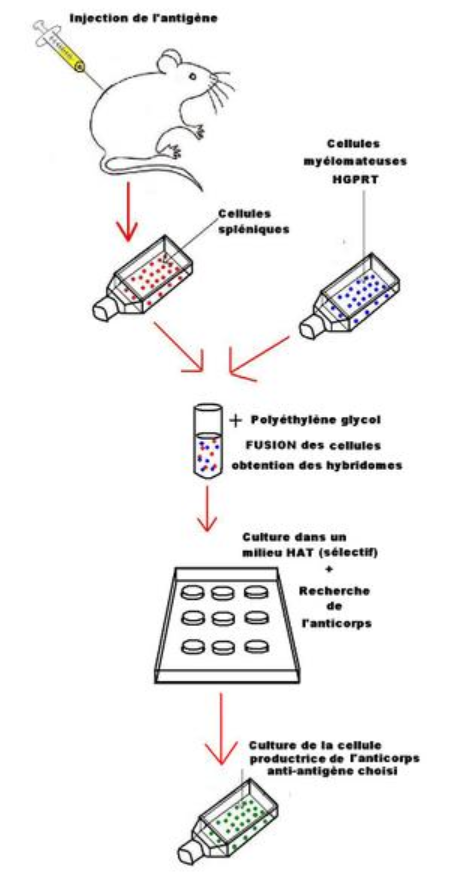Monoclonal Antibodies – Definition
The monoclonal or monoclonal antibodies are identical because they are produced by a clone of specialized cells of the immune system (plamocytes). Monoclonal antibodies are widely used in biology and medicine, both as diagnostic tools and for therapeutic purposes.
The production of these antibodies in vitro is very difficult because of the short lifespan of the plasma cells.
In vivo, the production of these antibodies can be obtained by injecting a given antigen into the animal and then extracting them from the blood. This method is very expensive and very few antibodies are obtained.
The development of the hybridoma technique by César Milstein and Georges köhler in 1975 made it possible to obtain a large quantity of antibodies at low cost and thus allow them to be used in numerous applications.
This technique consists of injecting the antigen of interest into a mouse and then taking, after a few weeks, the cells of the spleen. Among these cells are plasma cells secreting antibodies directed specifically against the chosen antigen. These plasma cells are fused with tumor cells called myeloma cells (immortal cells) thanks to the addition of polyethylene glycol (PEG) which induces membrane fusion and thus makes it possible to obtain hybridomas which have the capacity to multiply faster than normal body cells produce antibodies and develop specific antibodies indefinitely. The cells are then distributed in multiwell plates so that there is only one cell per well. In order to eliminate the plasma cells and the non-fused myeloma cells, a selective culture medium (HAT culture medium) will be used. Unfused plasma cells die quickly and the myeloma cells used which have a non-functional gene for an enzyme involved in the synthesis of nucleotides-hypoxanthine – guanine – phosphoribosyl – transferase (HGRPT) are unable to survive in HAT (hypoxanthine aminopterin thymidine) medium.
Only hybrid cells multiply. After ten days, each well is checked for the presence of antibodies against the antigen used to immunize the mouse. The producer cells are transplanted. A few producer cell clones are thus isolated which can be stored in liquid nitrogen.

Monoclonal Antibodies – Application examples
Ovulation test:
The anti-luteinizing hormone monoclonal antibodies which reveal the increase in the level of hormone LH (precursory sign of ovulation).
Pregnancy test
The principle is based on the detection of the hormone hGC (human Chorionic Gonadotropin) in the urine through a specific colored reaction through the use of anti-hGC monoclonal antibodies.
Treatment
Manufacture of monoclonal antibodies against antigens carried by tumor cells in order to destroy them. The advantage of using monoclonal antibodies for anti-cancer treatment lies in their specificity in destroying target cells. One can either use antibodies alone (naked antibodies) which by attaching to the cell cause its death or associated with another molecule such as a toxin or a radioactive product. The antibody serves in this case there, to bring towards the tumor cell the element which will destroy it.
ELISA test
Use of monoclonal antibodies as tracer antibodies in the ELISA test (Enzyme Linked Immunosorbent Assay). This type of test is used in particular in screening for seropositivity to the HIV virus, that is to say to demonstrate the presence of anti-HIV antibodies in the serum.
Monoclonal Antibodies – Disadvantage
Since most monoclonal antibodies are produced in rodent cells, an immune reaction can be seen when injected into a patient. This immunity gradually inactivates the beneficial action of the monoclonal antibody. To remedy this problem, “chimeric” or “humanized” antibodies are produced.
Chimeric Antibodies
The “chimeric” antibodies are obtained by grafting the constant parts of human immunoglobulin onto the variable parts of a mouse antibody.

Humanized Antibodies
“humanized” antibodies are produced by microbial fermentation or by transgenic mice containing only part of the human genes that make the Antibodies. They are potentially better tolerated in the human body.